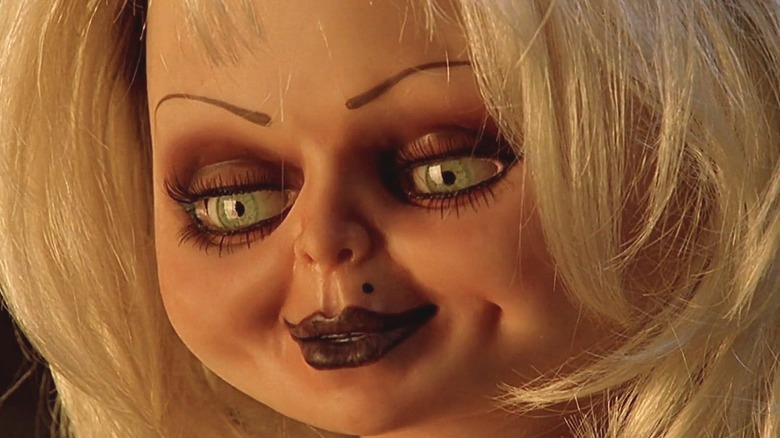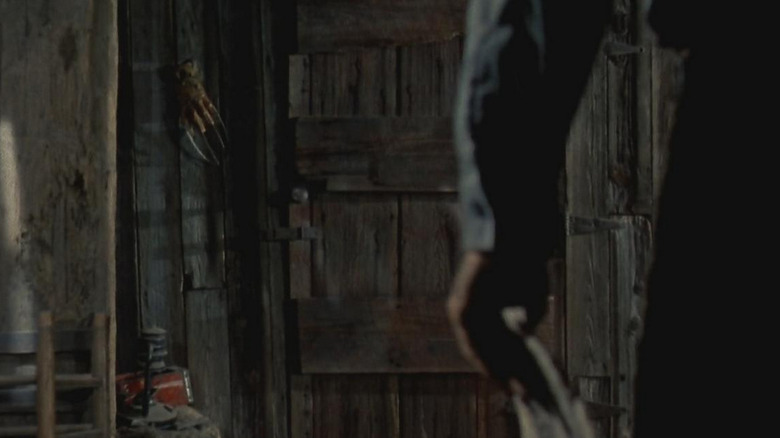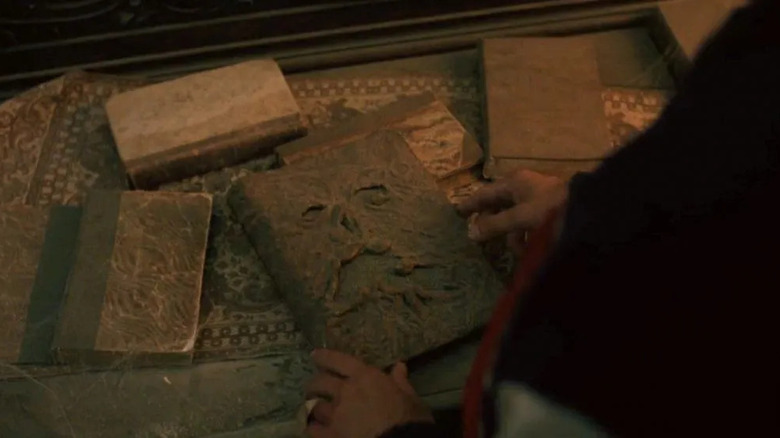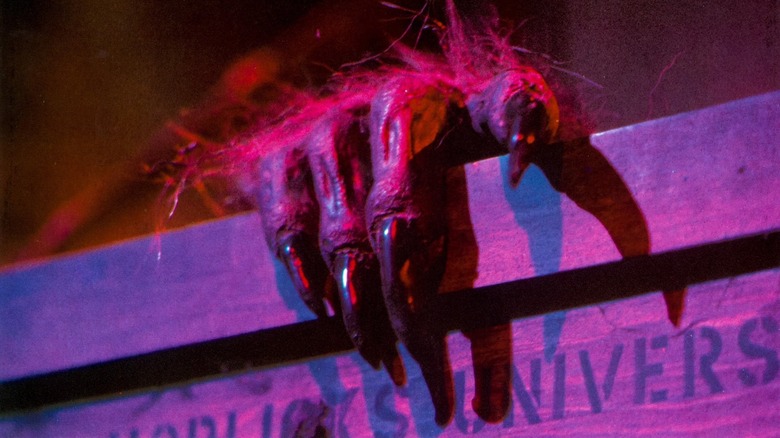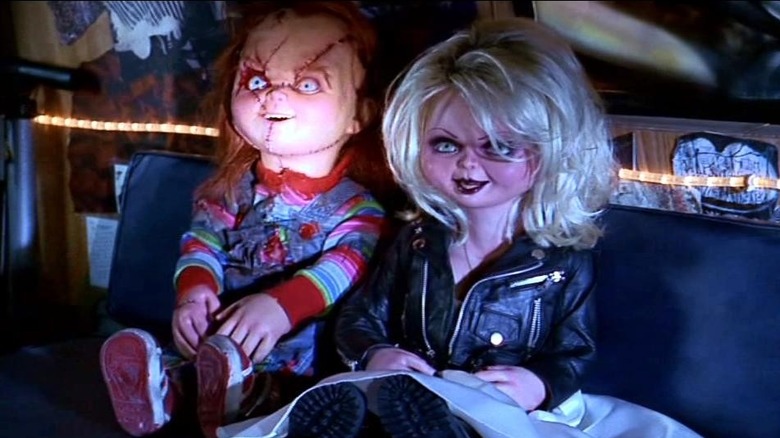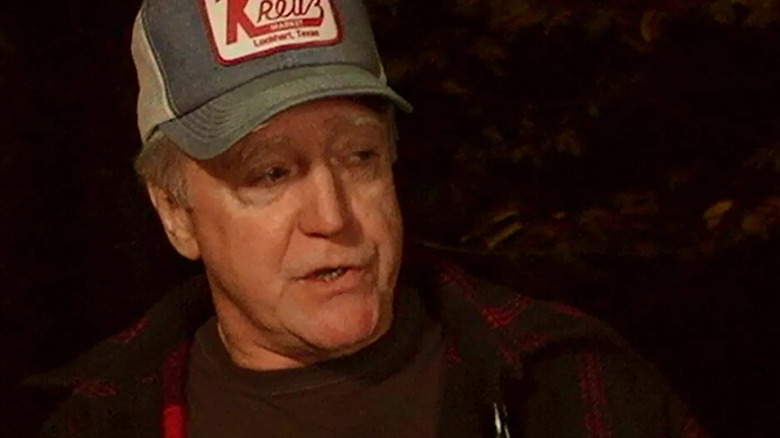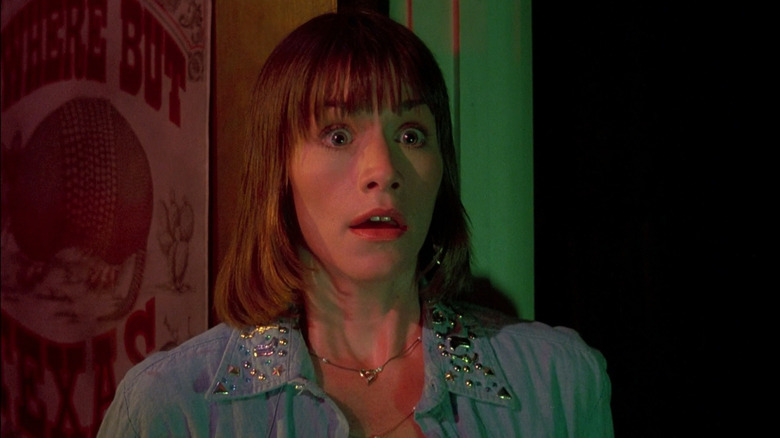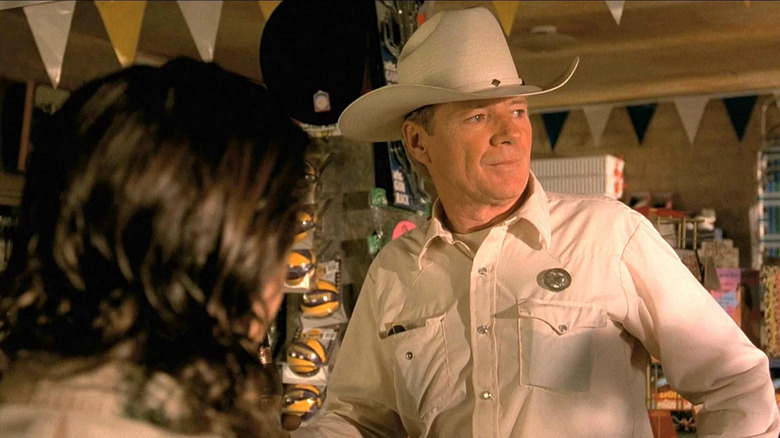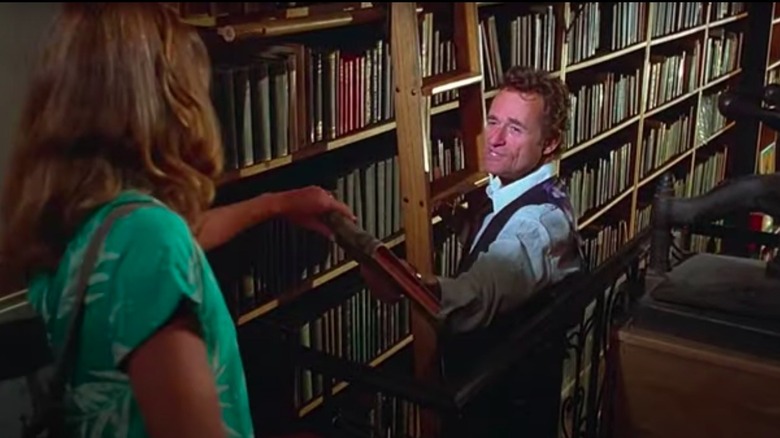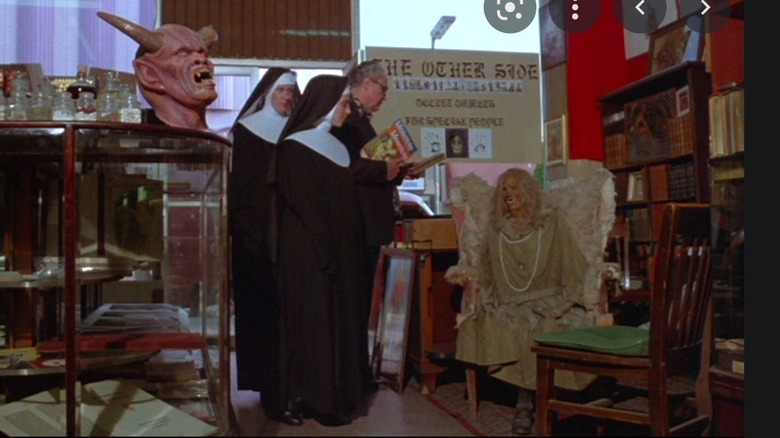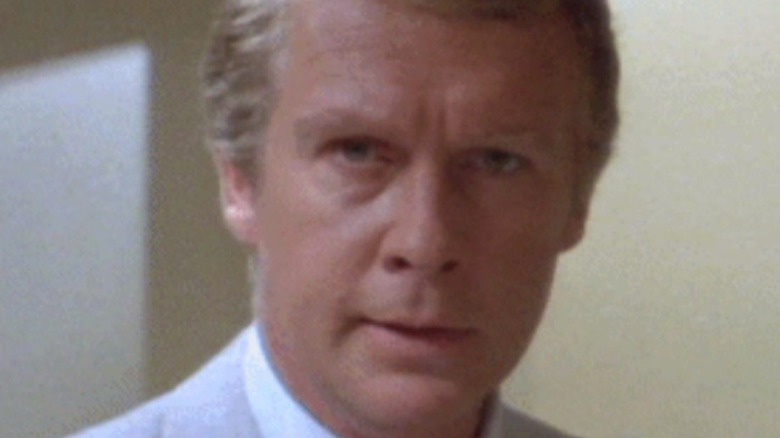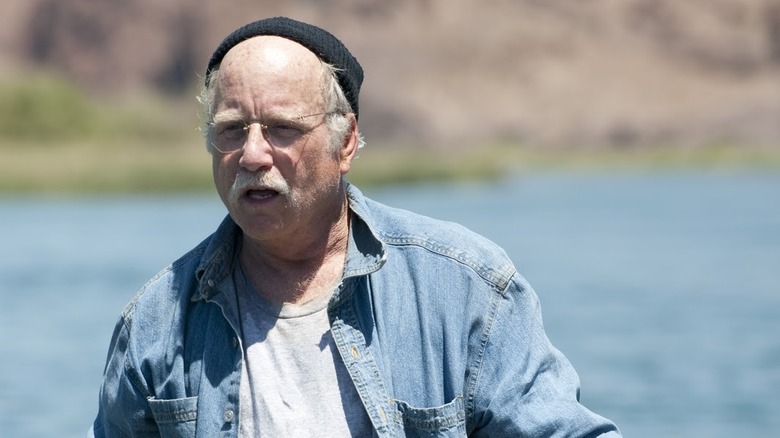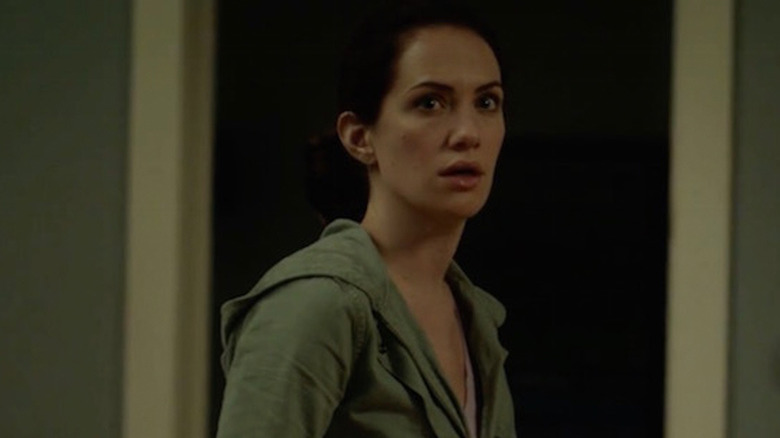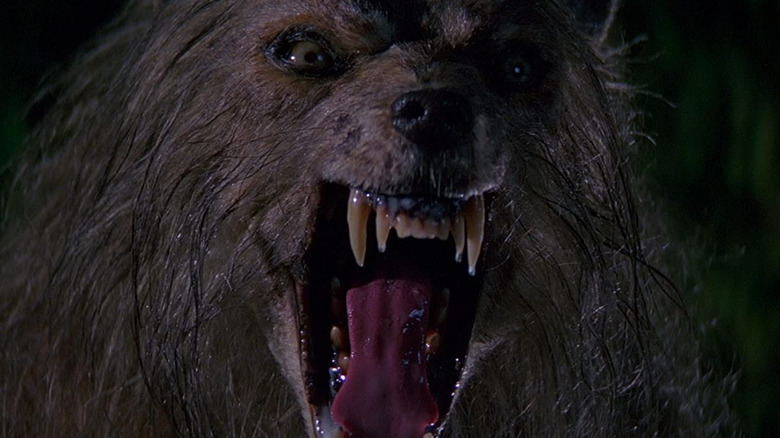Horror Films You Didn't Know Were Connected
Horror is one of the most popular and oldest genres of film there is. As long as film itself has been around, so too have horror movies, going back to Georges Melies' 1896 short, "The Devil's Castle." As prevalent as horror has been and continues to be in modern pop culture, so too has the idea of a shared universe linking films together. In fact, thanks to Universal's brand of monster films in the late 1930s and 1940s, one of the earliest examples of a cinematic shared universe can be found in such horror films as "Frankenstein Meets the Wolf Man" and "Abbott and Costello Meet Frankenstein."
Decades after Universal's classic monster movies, the idea of an interconnected world between horror films continues to exist with modern crossovers like "Freddy vs. Jason." Aside from those big-name crossover films, however, there are also a number of smaller connections between certain well-known horror movies that seemingly establish them to exist in the same universe. Sometimes these connections can be as minor as a certain prop turning up in the background. Other times they can be more explicit, with a character from one film turning up in another.
Here are some of the most interesting connections between popular horror movies that place them in the same fictional world.
Evil Dead II and A Nightmare on Elm Street
Throughout all three films that make up the "Evil Dead" trilogy and his later TV series, "Ash vs. Evil Dead," creator Sam Raimi weaves in a number of references to iconic horror movies, the most notable of these being a direct tie-in to Wes Craven's "A Nightmare on Elm Street."
In a brief blink-and-you'll-miss-it moment, eagle-eyed fans can spot the iconic bladed glove of Freddy Krueger in the work shed sequence in "Evil Dead II." If that weren't enough, Freddy's glove also appears in a similarly small capacity in "Ash vs. Evil Dead," still hanging in the same spot in the work shed when Ash returns to the cabin decades after the events of "Evil Dead II." According to Esquire (via Bloody Disgusting), the explanation behind the appearances of Freddy's glove in the film and Raimi's TV series dates back to a friendly game of one-upmanship between Raimi and Craven.
Noticing a torn poster for "Jaws" in the background of Craven's "The Hills Have Eyes," Raimi decided to include a poster for "The Hill Have Eyes" in his first "Evil Dead" movie, as if to hint that Raimi's film was scarier than Craven's. In turn, Craven included a scene from "The Evil Dead" in "A Nightmare on Elm Street," prompting Raimi to include Freddy's famous glove in "Evil Dead II."
The Evil Dead series and Jason Goes to Hell: The Final Friday
"A Nightmare on Elm Street" isn't the only horror franchise that "The Evil Dead" series ties into. In the ninth installment of the "Friday the 13th" series, "Jason Goes to Hell: The Final Friday," the movie's director included several props from the "Evil Dead" films that seemed to connect his film with Raimi's horror series.
In "Jason Goes to Hell," items like the Necronomicon Ex-Mortis and the Kandarian Dagger from "The Evil Dead" are prominently shown, with one character even momentarily flipping the pages of the Necronomicon. Rather than it being a simple homage like the inclusion of Freddy's glove in "Evil Dead II," the director of "Jason Goes to Hell" made it very clear that the link runs much deeper than a mere visual reference.
In an interview with Horror Geek Life, "Jason Goes to Hell" director Adam Marcus says the appearance of the Necronomicon is meant to non-verbally establish that Jason Voorhees' mother, Pamela, read from the book in order to raise her son from the dead. As Marcus sees it, such an explanation helps provide a feasible reason for why Jason goes from a young boy to an unstoppable killing machine by the second "Friday the 13th" film — he's a Deadite. Marcus fully supports his self-created fan theory, telling naysayers who claim the film isn't "Evil Dead" canon, "It absolutely is canon."
Creepshow and Jason Goes to Hell: The Final Friday
Along with the appearance of the Necronomicon from "The Evil Dead," another prop from a vastly different horror movie is seen in "Jason Goes to Hell" in the form of a large wooden crate labeled "Arctic Expedition Julia Carpenter Horlicks University." To most fans, this might just seem like a meaningless artifact kept in storage by Pamela Voorhees for some unknown reason. But for hardcore fans of director George A. Romero or Stephen King, the crate is a direct tie-in to Romero and King's 1982 horror anthology film, "Creepshow." The box seen in the Voorhees' basement is the same one in the segment of "Creepshow" titled "The Crate," right down to the identical exterior label.
In King and Romero's film, the crate houses a strange, man-eating, ape-like creature that devours several unlucky individuals. At the end of the segment, the survivors of the creature's rampage once again confine the creature to the crate, throwing it into a nearby lake where it will hopefully drown (although the creature's later seen chewing through the wooden planks of the box in a bid to escape). Is this the same lake where Jason drowned as a child? It's difficult to say for certain, but it seems like that may be the case. Perhaps Pamela stumbled upon the crate while looking for her son's body — though it seems by this time, the creature inside has long since broken free.
Several classic slashers and Bride of Chucky
Taking a more comedic approach to the slasher genre, "Bride of Chucky" is known for acting almost as an outright spoof of slashers than anything else and pokes fun at numerous easily recognizable horror movies of its day. Slasher fans can spot any one of the large amount of references the movie makes to well-known horror films, with the most straightforward example of this being seen in the movie's opening moments.
The scene in question finds main antagonist Tiffany Valentine (Jennifer Tilly) hiring a corrupt police officer to retrieve Chucky's remains from police custody. Venturing into the department's evidence locker room, the police officer passes several artifacts of slasher fame, including Michael Myers' white mask from "Halloween," Jason's hockey mask from "Friday the 13th," and Freddy Krueger's blade-fingered glove from "A Nightmare on Elm Street." There's also a chainsaw that may be the property of either Ash from "Evil Dead" or Leatherface from the "Texas Chain Saw Massacre" series.
Several horror classics and Behind the Mask: The Rise of Leslie Vernon
Like "Bride of Chucky," the mockumentary "Behind the Mask: The Rise of Leslie Vernon" offers a more satirical take on slasher movies, containing dozens of references to some of the genre's most famous films. Some of these are overt — such as the appearance of Robert Englund, the original actor behind Freddy Krueger — while others are more subtle, such as a reference to the film often credited with pioneering the genre in the first place: 1974's "Black Christmas."
Widely seen as one of the most influential horror movies ever made, "Black Christmas" isn't altogether as instantly recognized as later horror entries like "A Nightmare on Elm Street" or "Friday the 13th." However, it remains an important enough film to warrant a key reference in "Behind the Mask." In the film, aspiring serial killer Leslie (Nathan Baesel) eagerly tries to cement himself in the annals of iconic slasher villains under the guidance of his mentor, Eugene (Scott Wilson).
While it's never directly stated, "Behind the Mask" screenwriter David J. Stieve told Bloody Disgusting that Eugene was originally meant to actually be the main villain of "Black Christmas," an unseen killer known only as Billy. Despite the lack of confirmation in the finished film, there are still several references hinting that Eugene and Billy are one and the same: at one point Eugene gripes that he never got the same recognition as other famous killers like Michael Myers or Freddy Krueger, even though he was active long before them.
The Texas Chain Saw Massacre and Sharknado
"Sharknado" is a horror series that falls under the umbrella term "so bad, it's actually kind of good." Comprised of sequels, prequels, spin-offs, and even video games and comics, the "Sharknado" franchise is known for its laughably poor effects, its over-the-top acting, and its endless supply of celebrity cameos. Like every entry in the franchise, "Sharknado: The 4th Awakens" is no exception to this latter rule, containing cameos ranging from WWE superstars like Seth Rollins to comedians like Gilbert Gottfried and Carrot Top.
One of the minor characters to appear in the film is a character taken straight from "The Texas Chain Saw Massacre" series, with the final girl of "Texas Chainsaw Massacre 2" appearing in a small role in "Sharknado: The 4th Awakens." In "Texas Chainsaw Massacre 2," Caroline Williams plays radio DJ Vanita Brock, better known by her nickname, "Stretch." Surviving her run-in with the cannibalistic Sawyer family, Stretch goes on to appear in "Sharknado," once again played by Williams in a small but entertaining cameo.
By the events of "Sharknado," Stretch has settled down, fittingly opening a chain saw store with her friend, Chop Top, played by Duane Chapman (better known as Dog the Bounty Hunter). The concept of a chain saw store is an obvious reference to Williams' starring role in "Texas Chainsaw Massacre 2," but the name of Chapman's character also serves as a homage to the film, sharing his name with the member of the villainous Sawyer clan who menaces Stretch.
Planet Terror and From Dusk Till Dawn
Since his debut with 1992's "Reservoir Dogs," filmmaker Quentin Tarantino has created one of the most layered filmographies of any director working today, mastering such diverse genres as Westerns, crime films, kung fu movies, and horror films. As drastically different as each of his movies are, almost all of Tarantino's films have been revealed to exist within one massive shared universe known as the Tarantinoverse.
In certain cases, the connections between Tarantino's films may be something as small as a fictional product (like his signature Red Apple Cigarettes). Other times, it'll be larger, such as a character who crosses over into other Tarantino films. One great example of this is his Southern lawman, Sheriff Earl McGraw, played by regular collaborator Michael Parks, who's appeared in several Tarantino-related films.
Introduced in the Tarantino-penned "From Dusk Till Dawn," McGraw seemingly meets his end at the hands of the fugitive Gecko brothers at the start of the film. However, the character went on to appear in a handful of other Tarantino films, including "Kill Bill" and "Death Proof," as well as Robert Rodriguez's "Planet Terror," meaning that each one of these films exist within the same universe.
A Bucket of Blood, The Howling, and more
Alongside Earl McGraw and Stretch, there are other characters that string various horror movies together. One such character with a surprisingly large amount of appearances is Dick Miller's Walter Paisley. Originally introduced in Roger Corman's dark 1959 comedy-horror film, "A Bucket of Blood," Paisley went on to appear in some of the most notable horror movies of the 1980s.
In "A Bucket of Blood," Miller's Paisley is a struggling busboy turned serial killer who becomes a sensational artist after covering his victims' remains in clay. Paisley meets his grisly end at the conclusion of Corman's film, yet several other characters played by Miller (each of whom were named Walter Paisley) appeared in several more films that followed. In 1976, Miller returned to the character in Joe Dante and Allan Arkush's directorial debut, "Hollywood Boulevard," with Paisley this time being a talent agent.
Paisley turned up again in Dante's 1981 werewolf film, "The Howling," as the owner of an occult bookshop. In 1983, he popped up in Dante's segment of the horror anthology, "Twilight Zone: The Movie," appearing as the owner of a diner. Three years later, Miller appeared in the comedy-slasher film "Chopping Mall," with Paisley as a janitor murdered by a mall's high-tech security system. Other characters named Walter Paisley, played by Miller, also showed up briefly in 1986's "Night of the Creeps" and 2019's "Hanukkah" — which ended up being Miller's final film, posthumously released nearly a year after the actor's passing.
The Texas Chain Saw Massacre and The Howling
Aside from Walter Paisley serving as a link between several horror films, there is another major connection that places Joe Dante's "The Howling" and an iconic slasher franchise in the same universe. Ironically, this connection can be spotted in Paisley's occult bookstore, with the mummified remains of a woman spotted in the background. While the remains appear to be a random woman at first glance, a more careful look at the body reveals that this is actually the corpse of Grandma Sawyer from the original "Texas Chain Saw Massacre."
As the mummy is spotted in a bookstore primarily dealing with the occult, it shouldn't be surprising that a notorious figure like the Sawyers' matriarch found its way into Paisley's macabre collection. More than likely, Grandma Sawyer's appearance in the film can be explained by the fact that "The Howling" production designer Bob Burns also worked on "The Texas Chain Saw Massacre," likely using props he already had on hand from that film to stock Paisley's bookstore.
Still, it's interesting to wonder what a universe where Leatherface battles werewolves, and what the resultant carnage that would ensue from such an epic encounter, would look like.
Gremlins and The Howling
In addition to its connection with Tobe Hooper's "The Texas Chain Saw Massacre," "The Howling" also happens to tie into another of director Joe Dante's works. In the film, a news anchor named Lew Landers (Jim McKrell) appears briefly, seemingly named in part for the director of the 1943 Bela Lugosi-starring "The Return of the Vampire" — one of the many nods Dante makes to past monster-themed films.
In Dante's follow-up film, "Gremlins," McKrell once again appears in a minor capacity as Lew Landers, this time reporting on the Mogwai invasion of Kingston Falls. The connection is a small one, but it's still interesting to see Landers appear in a manner that ropes the two Dante-directed films together.
Aside from Landers' appearance in both films, there is a small visual connection that further links Dante's two movies. In a small scene in "Gremlins," a yellow smiley face sticker appears on the Peltzer family's refrigerator. This can be seen as a reference to the calling card of Eddie Quist, a serial killer in "The Howling," who leaves behind smiley face stickers at the locations of his past murders.
Jaws and Piranha 3D
In the decades following the release of "Jaws," dozens of films have tried to cash in on that landmark movie's success by depicting everyday animals as uncharacteristically aggressive maneaters, from alligators ("Alligator") and killer whales ("Orca") to bears ("Grizzly") and wild boars ("Razorback").
The most notable of these "Jaws" rip-offs is Joe Dante's 1978 film, "Piranha," the movie that led to Dante's rise in Hollywood. Receiving mixed reviews at the time of its release, the film went on to achieve cult status in the years that followed. It led to a sequel and two remakes, one of which was released in 2010 as "Piranha 3D."
Coming full circle with the undeniable influence of "Jaws" on the film, "Piranha 3D" opens with an elderly fisherman being devoured by a school of ravenous piranhas emerging from an underwater cave. The fisherman — played by Richard Dreyfuss — appears to be wearing an identical outfit to the one worn by his character, Matt Hooper, in "Jaws." As it turns out, this was not an accident, but an intentional effort to establish the fact that Dreyfuss is playing the same character in both films. As Dreyfuss told Hollywood News, "I play the older Matt Hooper, who escaped being eaten by the shark and is now eaten by a bunch of piranha fish."
Hush and Gerald's Game
Mike Flanagan has cultivated quite an impressive reputation as a modern horror director, tackling several ambitious adaptations of Stephen King's work and helming some of his own equally entertaining original projects. A link between two of the director's best projects can be found in his 2017 Netflix thriller, "Gerald's Game," based on King's novel of the same name.
In the film, the main character, Jessie (Carla Gugino), is left chained to a bed while getting intimate with her husband (Bruce Greenwood), who suddenly passes away from a heart attack. As Jessie searches for ways to free herself from her handcuffs, viewers can see a book on a shelf above Jessie's bed in several scenes. The book, titled "Midnight Mass," is written by Maddie Young — the main character played by Kate Siegel in Flanagan's previous film, "Hush."
As if that weren't connection enough, the title of Maddie's book would even serve as the namesake for Flanagan's later effort, "Midnight Mass," an excellent horror miniseries in its own right.
Dog Soldiers and The Descent
Director Neil Marshall is responsible for delivering some of the most vastly underrated horror movies of the past few decades, two of which include his wonderful 2002 werewolf film, "Dog Soldiers," and his claustrophobic 2005 horror shocker, "The Descent." As vastly different as the two movies are, they do share common threads that place them within the same nightmarish universe.
The connection between the two films can be seen in "The Descent," when the film's main character, Sarah (Shauna Macdonald), looks over the various skeletal remains of past meals devoured by the carnivorous creatures living in the underground cave system. In the scene, Sarah briefly scans over what looks like the head of a giant werewolf from Marshall's previous film, "Dog Soldiers."
In another minor scene in the film, Sarah picks up an old helmet with the name "Oswald" written across it that she finds in the underground cave. This serves as another tie-in to "Dog Soldiers," referencing a close friend of that film's chief protagonist, Harry G. Wells (Sean Pertwee), who Wells reminiscences about in the film. While Wells reveals that Oswald met his end via a landmine in the Iraq War, it's worth wondering if he'd maybe ventured into the same cave system shown in "The Descent" sometime before his gruesome demise.
